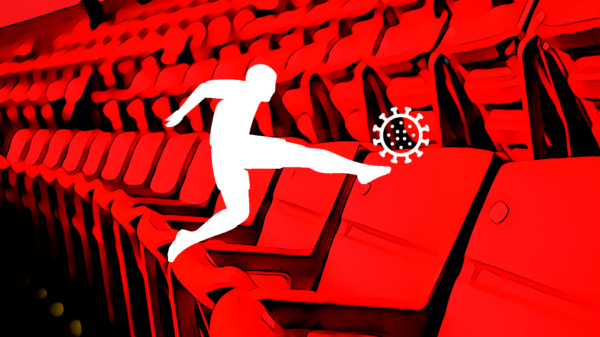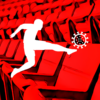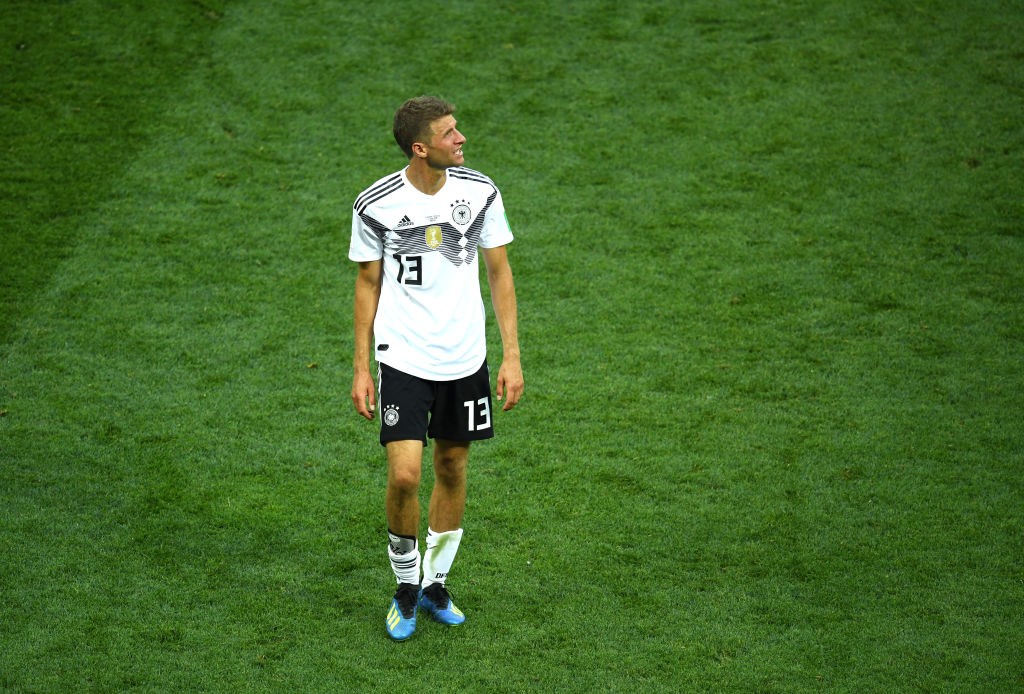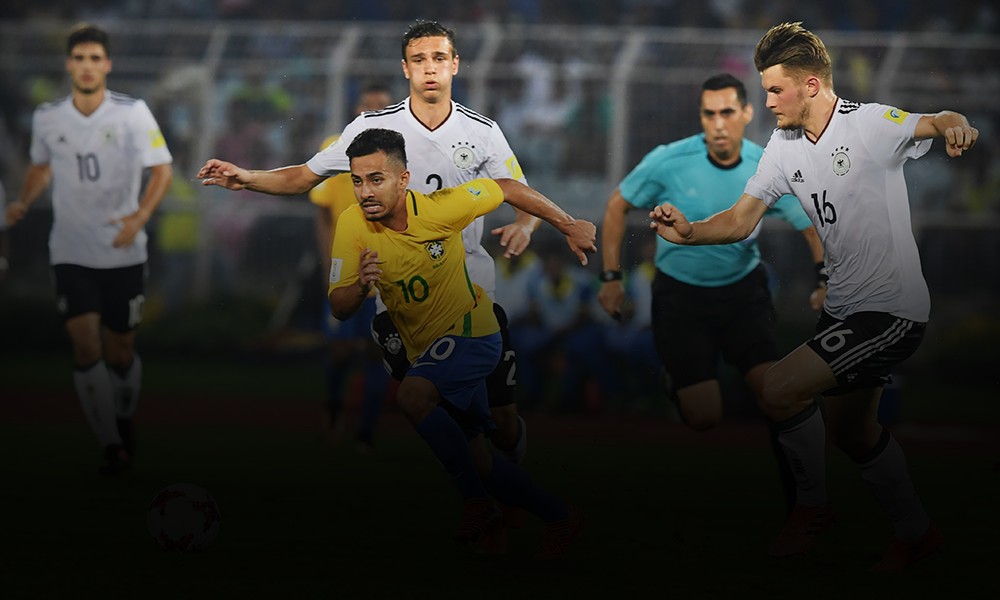Ross Eaton provides an in-depth tactical analysis on Group C’s game between Germany and Poland.
In one of the most anticipated group games of Euro 2016, Germany faced Poland in what would surely decide who finished top of Group C. The Poles have one of their strongest teams of all time, while Germany continue to impress following their 2014 World Cup win. At the Stade de France, two teams with many tactical possibilities battled for superiority.
Germany 0-0 Poland
Line-Ups

Germany: 1.Neuer, 4.Howedes, 17.Boateng, 5.Hummels, 3.Hector, 13. Muller, 6.Khedira, 18.Kroos, 11.Draxler, 8.Ozil, 19.Gotze
Poland: 22.Fabianski, 20.Piszczek, 2.Pazdan, 15.Glik, 3.Jedrzejczyk, 16.Kuba, 5.Maczynski, 10.Krychowiak, 11.Grosicki, 7.Milik, 9.Lewandowski
Germany made no changes from their opening group win over Ukraine. Manuel Neuer was in goal; ahead of him was Benedikt Howedes, Jerome Boateng, Mats Hummels who recently returned from injury, and Jonas Hector. The highly popular midfield pairing of Sami Khedira and Toni Kroos played between defence and attack. On the right of attack was Thomas Muller, Mesut Ozil playing 10, while Draxler was on the left. Mario Götze retained his place spearing the attack.
Poland, in a 4-4-2 formation, had Lukasz Fabianski in net. A back-four ahead of him was made up of Lukasz Piszczek, Michal Pazdan, Kamil Glik and Artur Jedrzejczyk. Protecting the defence was a double-pivot of Grzegorz Krychowiak and Krysztof Maczynski. The right and left of them were Jakub Blaszczykowski and Kamil Grosicki. The two forwards were Arek Milik and Robert Lewandowski.
Resilient Defence
In a game where Germany, a side with a large handful of creative talents within their ranks, were prevented from scoring a goal, the opposition must have been doing something right, particularly in terms of defence. Poland defended in a structure which resembled a 4-4-1-1, with a strong focus on compactness between the banks of four.
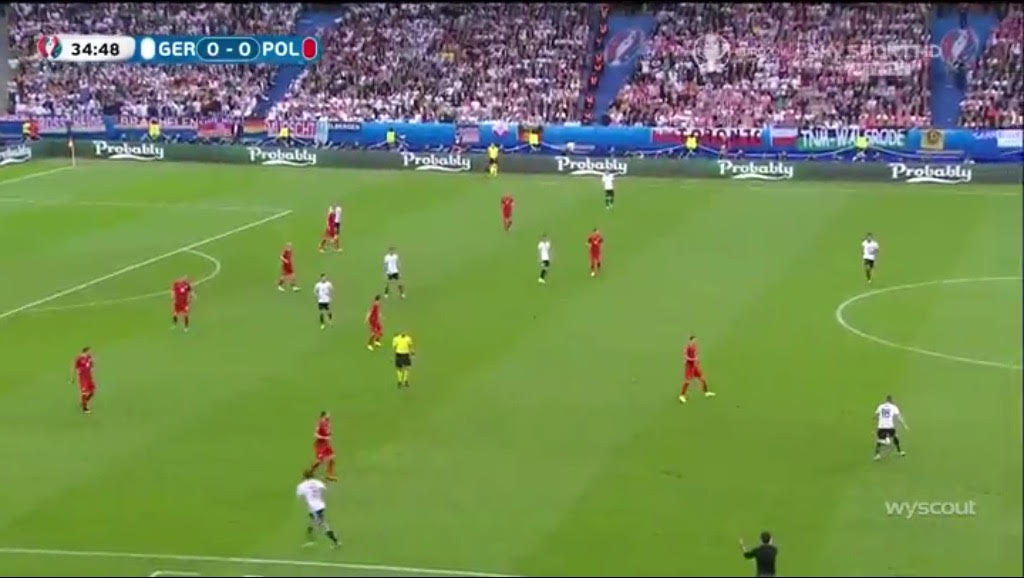
This strong focus on vertical compactness in a mid-deep block was no doubt to nullify the threats of Mario Götze and Mesut Özil, two players who are both very strong when given space between lines.
Although Poland were very vertically compact within the first two lines, they clearly didn’t have as prominent a focus on horizontal compactness. More often than not without the ball, Jakub Blaszczykowski and Kamil Grosicki could be seen in the halfspaces, with their respective full-backs Piszczek and Jedrzejczyk not much narrower than them. Deep in their own half, this left the halfspaces relatively open which against Germany would normally be a mistake. On the night though, Germany played quite wing-orientated, most likely to escape the vertical compactness of Poland in their strongest area, Zone 14. Similarly to the way Bayern played against Juventus in the Champions League last 16, Germany frequently used the wings in order to escape the compact centre of the field. This meant a heavy reliance on Germany’s best long passers, Boateng, Hummels and Kroos to play long passes into the wide areas. In order to disarm Germany’s best weapon from deep, Milik man-marked Kroos during Germany’s build-up.
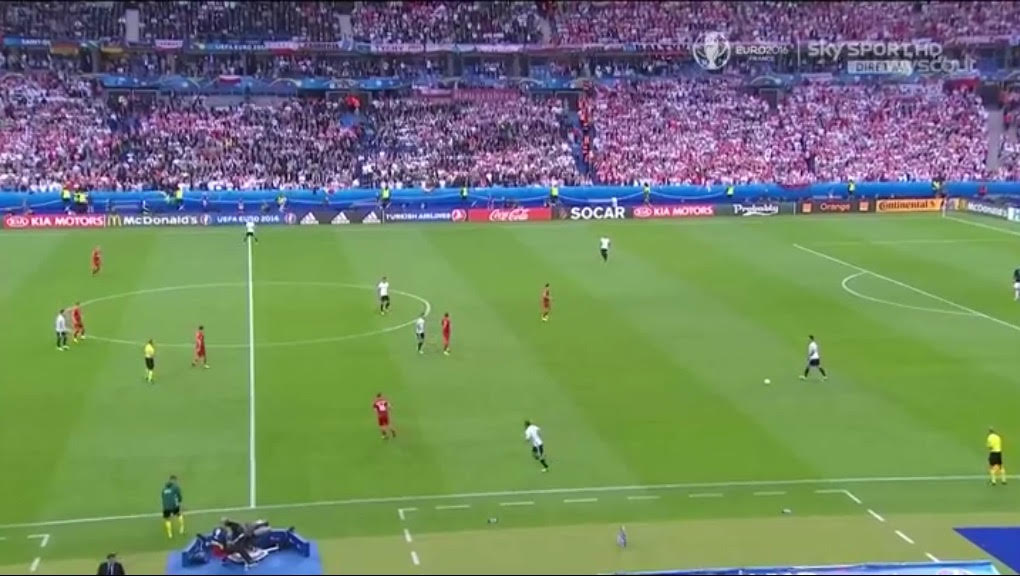
This made it far more difficult for Kroos to receive the ball from a short pass from Neuer, Boateng or Hummels.
Germany’s Attacking Patterns
As already mentioned, Germany were wing-orientated in a bid to escape Poland’s compact core. In order to do so, Germany used long-passes to switch the play as well as attacking patterns to combine in the wide areas to create chances.
During the build-up, left-back Jonas Hector positioned himself very high on the left wing, while left-winger Julian Draxler moved slightly inside to the halfspace. Jerome Boateng, playing as RCB would often looked for a high diagonal pass to Hector and as this happened, a couple of options opened up. As Hector received the pass, Draxler had the option to move inside even further, or simply make his way into the box. This left Hector in a 1v1 on the wing, a situation he is very strong in, and excelled in against Ukraine in the previous match. A second pattern we saw as Hector received the ball was the idea of creating a wide overload. Draxler would move back onto the wing, or at least closer to it, and whoever was closer to the ball of Götze and Özil, would also make a movement towards the flank.

The purpose was to create a wide overload, while Toni Kroos reminded slightly deeper in the halfspace, always offering to recycle the play to continue circulation or play a diagonal to Muller or Howedes on the opposite wing.
An overload wasn’t always created though, as Poland began to prevent this. Three Polish players were often sent out to defend on the wing, usually the full-back, ball-near 6 and winger. Despite this problem for Germany, they were usually able to escape a tough touchline press due to qualitative superiority of Ozil/Götze and Draxler in particular. This was a good situation now as having dragged Polish players onto the wing, out of position, Germany now had numerical superiority in the centre. Kroos then often switched the play to Muller, who was waiting on the wing, though he wasn’t always successful here, and Germany would’ve been stronger here if they had a better 1v1 attacker on the right wing.
Issues in the Centre
In great tactical battles, the match is usually won by the exploitation of a small mistake by one team. In this match, although both teams had tactical weaknesses, neither failed to take advantage, hence the 0-0 draw.
The first issue I will discuss is primarily regarding Milik and Khedira. With Milik marking Kroos, who was based in the left halfspace, for the majority of Germany’s possession, this meant he was offering very little defensively support to Lewandowski, who passively pressed Boateng and Hummels. Though some would say Lewandowski should simply have dropped and marked Khedira, this would have arisen issues itself. With Boateng and Hummels being such excellent passers, their creativity from deep could cause extreme problems to Poland should no attempt be made to limit their influence. The video below highlights the mistake Belgium made against Italy, which relates to this issue.
https://twitter.com/boxtoboxcb/status/742764061658632197
While Lewandowski pressed Boateng and Hummels, Milik marked Kroos wide on the left, and the midfield four remained deep and compact, Sami Khedira was the free man.
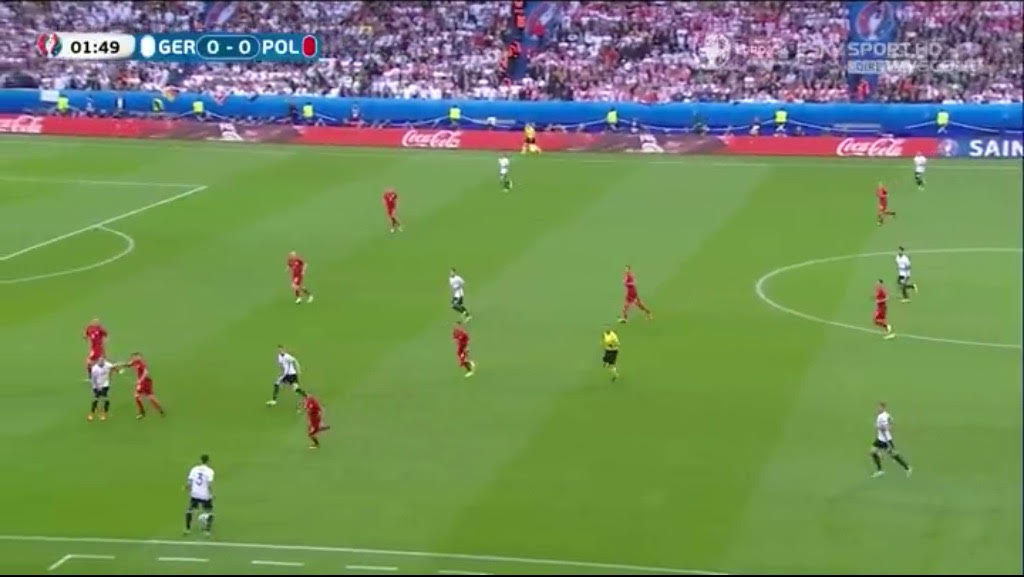
When he received the ball, he often had many yards of space ahead of him, due to Krychowiak and Maczynski being occupied with Ozil and a dropping Götze, and not being willing to press and concede an overload in Zone 14 with two of the best 10’s in the world. Khedira didn’t take advantage of this in the first half yet Low failed to change this at half-time, when he could have brought on Schweinsteiger or Weigl.
The second recurring tactical issue throughout the match was again down to the personnel Joachim Low started the match with. Using Mario Gotze as the centre forward was Low’s choice and although he wasn’t terrific against Ukraine, he made some nice movement and Germany generally didn’t need a traditional 9, as they created chances in other ways than crosses to a centre forward. Götze’s tendency to drop deep caused Germany more problems against Poland though.
The Bayern Munich man made things easier for Poland’s banks of four, as due to being unwilling to make vertical movements or runs in behind the backline, this lead to congestion through over occupation of the centre. This left Mesut Ozil with either no space to play in, or not enough movement to play his wonderful through passes to.
Original Purpose of Counterpressing Put to Good Use
After seeing Bastian Schweinsteiger top off a perfect German counter-attack with a goal against Ukraine. It is clear that despite their team not being blessed with pace, the Germans can certainly still pull off a deadly counter attack. All throughout the match we saw rapid counterpressing with three or four Poles often pressing the ball instantly after losing possession.
This significantly decreased Germany’s threat on the counter-attack due to not being able to escape such intense pressure within a turnover. Throughout the match we saw not a single notable German counter attack. Very effective counterpressing.
Conclusion
A resilient Poland side who have beaten Germany just once in their history put up a strong fight, taking a point as well as a strong step towards qualification managed to scrape a 0-0 draw. Germany will be very disappointed not just with the goalless draw but also with their performance. Die Mannschaft barely managed to create a chance, never mind needing a traditional 9 to finish them. The inclusion of Mario Götze as striker in the final group game against Northern Ireland would certainly be debatable, though in defence of he and Low, it would also be justifiable. Germany will without a doubt be anxious going into another game against a defensive minded opposition, with the threat of elimination at the first hurdle still a possibility.
Written by Ross Eaton
- Tactical Analysis: Nice 4-0 Monaco | Favre’s efficient approach - September 14, 2017
- Tactical Analysis: Australia 2-3 Germany | German Defensive Scheme - June 22, 2017
- Tactical Analysis: Napoli 1-3 Real Madrid | Napoli unable to shift momentum - March 9, 2017




















































